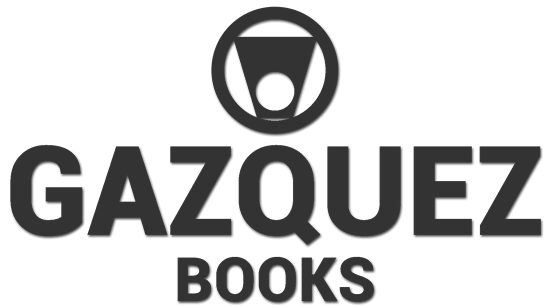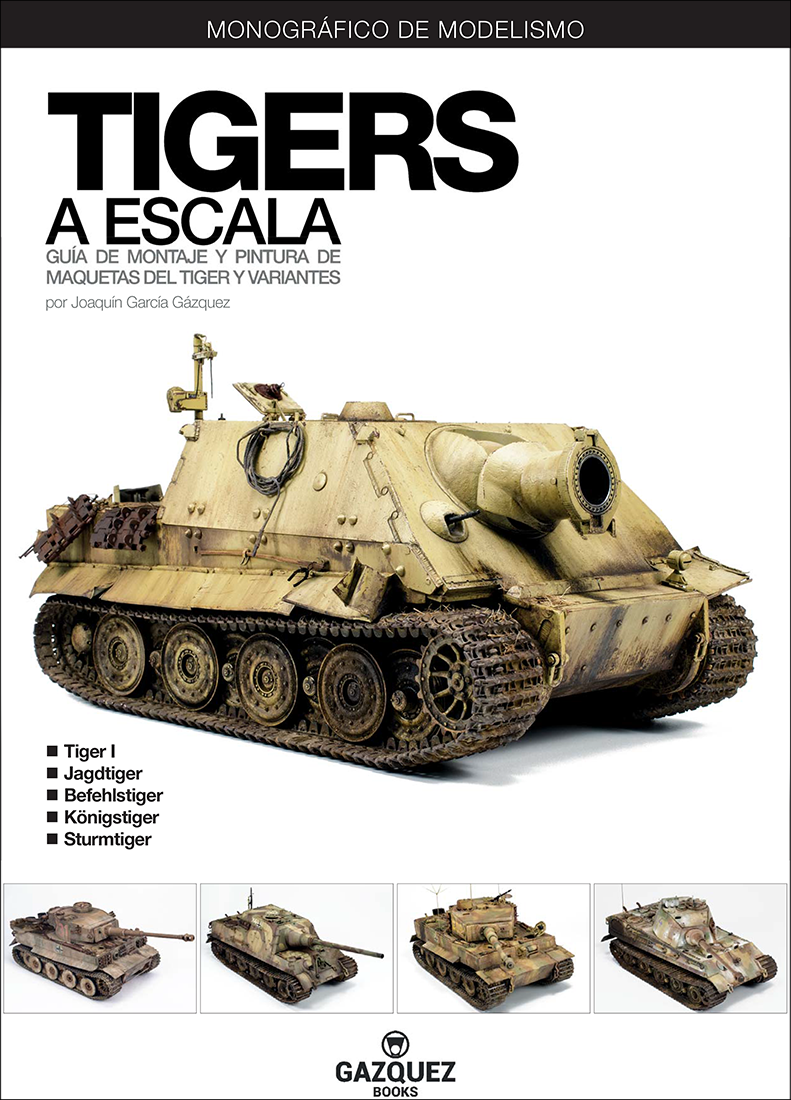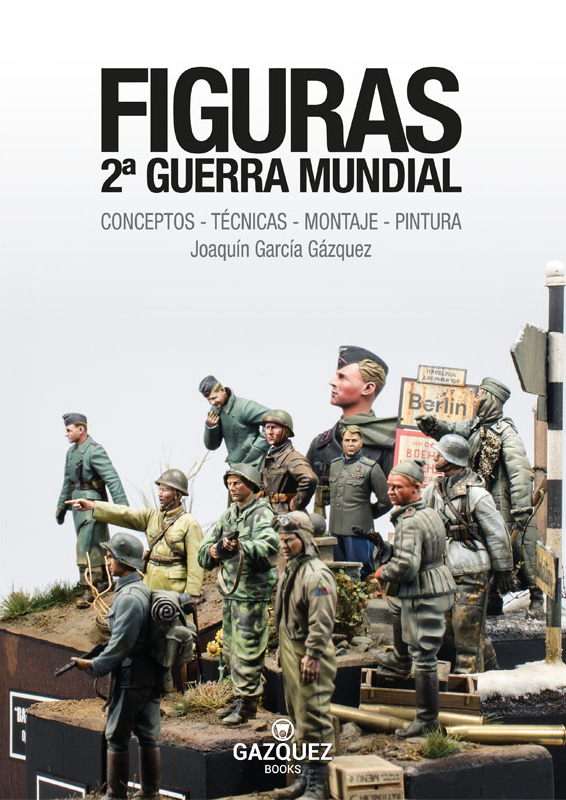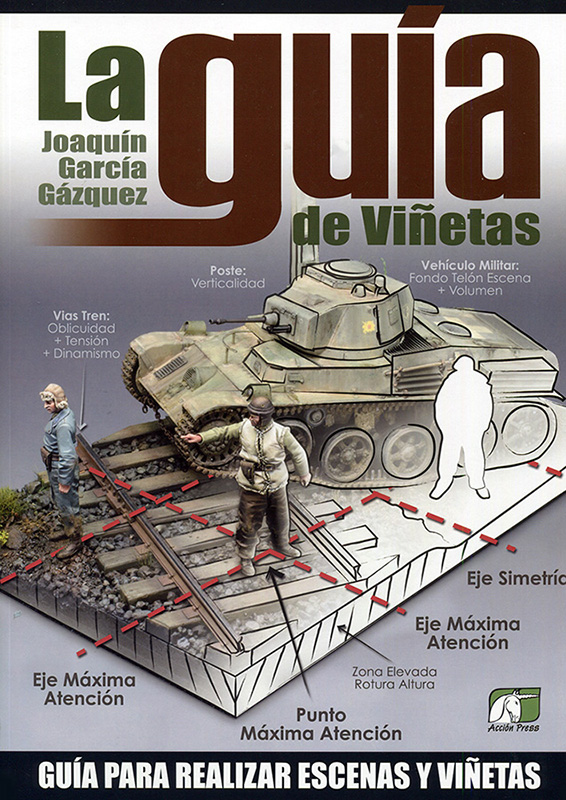#modelling_expands #gazquezbooks
Autor: Joaquin Gª Gazquez
Sd.Kfz.166 Sturmpanzer IV «Brummbär», Späte Produktion, «STUPA»
Soviet Tanker 1/35
Listo el carrista para el T-34/76, bonita experiencia pintar esta figura de Scale75, técnicas mixtas aerógrafo y pincel.
Buscando un estilo mas suelto y expresivo, pintura rápida y gestual, ideal para el acompañamiento de vehículos.
Sin más las fotografías:









modelling_expands #gazquezbooks #almeriamodelismo
Soviet Tanker 1/35 «in progress»
#modelling_expands #gazquezbooks #almeriamodelismo
Aprovechando la tarde en el Local de Almería Modelismo, he comenzado con esta figura de Scale75 para ambientar el T-34 «ChTZ».
 He utilizado proceso con aerógrafo, para obtener excelentes resultados en poco tiempo, de hecho a la figura le he dedicado 2 tardes, la del viernes y el sábado, hasta ahora no lleva mucho más de 8 horas de trabajo.
He utilizado proceso con aerógrafo, para obtener excelentes resultados en poco tiempo, de hecho a la figura le he dedicado 2 tardes, la del viernes y el sábado, hasta ahora no lleva mucho más de 8 horas de trabajo.
La figura de Scale75, en resina bien fundida, ha necesitado un tiempo mínimo antes de imprimar, en el debe, quizás unas proporciones mas cercanas al cánon de 8 cabezas de altura que al de 7 más habitual en las personas, por lo demás muy buena en pose y lenguaje corporal:

 Como hago habitualmente imprimación con primer negro de Vallejo aplicado a aerógrafo:
Como hago habitualmente imprimación con primer negro de Vallejo aplicado a aerógrafo:
 A continuación unas luces proyectadas con aerografo cenitálmente, para poner en valor la escultura, ver luces y sombras, y tener un boceto de trabajo sobre la misma:
A continuación unas luces proyectadas con aerografo cenitálmente, para poner en valor la escultura, ver luces y sombras, y tener un boceto de trabajo sobre la misma:

 Seguidamente con pinturas de Citadel en una gama de grises y negros, mediante transparencias con aerógrafo, obtuve la iluminación del mono de trabajo:
Seguidamente con pinturas de Citadel en una gama de grises y negros, mediante transparencias con aerógrafo, obtuve la iluminación del mono de trabajo:



 El siguiente paso las carnaciones, están pintadas con acrilicos artísticos Golden, en mi opinión, lo mejor que hay, unos colores vibrantes, pigmento puro y finísimo, las hacen ideales para carnaciones.
El siguiente paso las carnaciones, están pintadas con acrilicos artísticos Golden, en mi opinión, lo mejor que hay, unos colores vibrantes, pigmento puro y finísimo, las hacen ideales para carnaciones.
El color base esta formado, Naranja de Cadmio, Blanco y Siena Tostada. lo aplico con aerógrafo para obtener una capa fina de pintura:
 Se ilumina añadiendo Blanco y Amarillo Nápoles:
Se ilumina añadiendo Blanco y Amarillo Nápoles:



 El sombreado se obtiene con Azul, Alizarin Crimson y Sombra Tostada, también se pintan ojos, y boca:
El sombreado se obtiene con Azul, Alizarin Crimson y Sombra Tostada, también se pintan ojos, y boca:


 Para terminar por el momento, se hace un efecto de barba de varios días y se pinta el casco en color base para poner los «colores en su sitio», ver el conjunto y ya ir trabajando cada elemento:
Para terminar por el momento, se hace un efecto de barba de varios días y se pinta el casco en color base para poner los «colores en su sitio», ver el conjunto y ya ir trabajando cada elemento:
Espero os guste.
T-34/76 «ChTZ Stamped Turret»
Maqueta muy especial para mi, homenaje al 50 aniversario de la primera Maqueta Militar de Tamiya, contaré más al respecto una vez la tenga lista para pintar.
De momento el casco finalizado al 95%, siguiente paso la torreta.
Espero os guste, pronto más.
Very special model for me, tribute to the 50th anniversary of the first Tamiya’s Military Model, I will tell more about it once I have it ready to paint.
Now the hull is 95% finished, next step the turret.
I hope you like it, soon more.
#modelling_expands #gazquezbooks
M1A2 Abrams
Tamiya’s 1/48 M1A2 Abrams finished.
A great kit, which however has more work than it seems at first glance with many details to work with,
The figure is that of the kit with a head courtesy of Luciano Rodriguez.
Personally I’ve had a lot of fun.
I hope you like it.
#modelling_expands #gazquezbooks
Terminado el M1A2 Abrams de Tamiya a 1/48.
Un gran kit, que sin embargo tiene más trabajo de lo que parece a primera vista con muchos detalles a trabajar,
La figura es la propia del kit con una cabeza cortesía de Luciano Rodriguez.
Personalmente me he divertido mucho.
Espero os guste.
M1A2 Abrams, Paint Process [2]
Continuing where we left off in the previous post, the next step is to place the Echelon decals to make a 3rd ACR M1A2 in the «Operation Iraqi Freedom»:


Las calcas son muy finas, casi en exceso diria yo, los «B4» de los CIP, me resulto imposible colocarlos, por lo que la final me decidi a enmascarar con papel cuadriculado de Tamiya y pintarlos:
The decals are very thin, almost in excess I would say, the «B4» of the CIP, I found it impossible to place them, so the final I decided to mask with Tamiya squared paper and paint them:

Una vez puestas una ligera capa de barniz para unificar brillos y listo para el «guaterin»:
Once put a light coat of varnish to unify brightness and ready for the weathering:


El siguiente paso son filtros y oleos, para los filtros use el especifico de AK, y un esmalte amarillo de Humbrol:
The next step are filters and oils, for the filters use the specific AK, and a yellow Humbrol enamel:

Con los filtros, y oleos Gris Titan, Sombra Natural, Siena Natural, Gris de Payne Blanco y Negro trabaja todas las superficies, para obtener variedad de tonos, matices y sensación de uso:
With the filters, and oils Titan Grey, Natural Shade, Natural Siena, Payne Grey White and Black works all surfaces, to obtain variety of tones, nuances and sensation of use:



El siguiente paso son los desconchones, a imagen y semejanza de algunas fotografias, desconche sobre todo los guardabarros delanteros y el tubo del cañón, con acrilicos de vallejo y alternando pincel con la técnica de la esponja:
The next step is the flaking, in the image and similarity of some photographs, flaking especially the front mudguards and the barrel tube, with acrylic of valley and alternating brush with the technique of the sponge:


A partir de aqui me cuesta más contar de forma medianamente ordenada lo que hago, entro en fase «DEFCON 2» como yo la llamo, que consiste en hacer lo que me sale del alma, sin mucho orden ni método, es usar oleos, pigmentos, productos de acabado de AK, para viendo fotografías, ir haciendo manchas, rastros de combustible, suciedad, etc. etc.
From here I find it more difficult to tell in a moderately orderly way what I do, I enter the phase «DEFCON 2» as I call it, which is to do what comes out of my soul, without much order or method, is to use oils, pigments, AK finishing products, to see photographs, go making stains, traces of fuel, dirt, etc.. etc..




Para terminar por el momento, le puse en los periscopios y sistemas de puntería, las pegatinas transparentes del kit de Tetra Models, y las ametralladoras pintadas y en su lugar:
To finish for the moment, I put in the periscopes and aiming systems, the transparent stickers from the Tetra Models kit, and the painted machine guns and in their place:




Y de momento así se queda, lo dejare reposar unos días antes de hacerle el remate definitivo. Espero os haya gustado.
And for the time being that’s how it stays, I’ll let it rest for a few days before making the final auction. I hope you liked it.
Feliz 2019 / Happy 2019
«MILICIANO» S.C.W. 1937, ARCABUZ 1/16 (English version)
| Versión Texto Castellano |
#modelling_expands #gazquezbooks
I present you the bust that I am «perpetrating» right now, it is the reference of Arcabuz «Miliciano – 1937» to 1/16, this scale is very suitable for busts, because it presents the adequate detail to work well the faces, and it does not have an excessive size that ends up being an exhausting task for us.
Arcabuz’s miniature is modeled with 3D technology, digitally printed and then copied in resin.
I can say that I found it very good, although I noticed some line of the print, what I least liked is that the head comes attached to the body, this for me is not minor, as it makes it significantly difficult to paint with airbrush, be able to separate the head, and work it apart, we avoid complicated masked, but as I say, it is a matter of liking and personal organization of work, otherwise I think a great figure and I recommend you.
Let’s go to work, after a quick preparation, cover some tiny pore resin I primed in black with Vallejo’s «Primer Black», leaving it ready to start the work of airbrush:
![[IMG]](https://www.panzermodelling.com/wordp/wp-content/uploads/2018/12/AM_18_12_22_001.jpg)
Next with «Primer Grey» also by Vallejo, I gave it some lights to obtain a grisaille, which allows it to appreciate the volumes of the sculpture:
![[IMG]](https://www.panzermodelling.com/wordp/wp-content/uploads/2018/12/AM_18_12_22_008.jpg)
The obtained grisaille, will facilitate to appreciate the zones of lights and shades, and by transparency it will help us in the first layers of color.
![[IMG]](https://www.panzermodelling.com/wordp/wp-content/uploads/2018/12/AM_18_12_22_012.jpg)
The next step is to work the flesh tones of the face with airbrush, I have used acrylic artistic Golden «Heavy Body», which give a finish and a warmth to the carnations, for me, insurpassable, as I tell you, do not worry they airbrush to perfection.
I prepare the base color with Naples Yellow, Burnt Sienna, Cadmium Orange and a bit of Titanium White.
![[IMG]](https://www.panzermodelling.com/wordp/wp-content/uploads/2018/12/AM_18_12_22_017.jpg)
The grisaille applied, facilitates to obtain the first lights by the transparency that are obtained applying the acrylic in thin diluted layers.
![[IMG]](https://www.panzermodelling.com/wordp/wp-content/uploads/2018/12/AM_18_12_22_019-1.jpg)
Lightening the base color with Yellow Napoles and Titanium White, the lights are obtained, in applications with airbrush and the very diluted painting.
![[IMG]](https://www.panzermodelling.com/wordp/wp-content/uploads/2018/12/AM_18_12_22_030.jpg)
![[IMG]](https://www.panzermodelling.com/wordp/wp-content/uploads/2018/12/AM_18_12_22_031.jpg)
![[IMG]](https://www.panzermodelling.com/wordp/wp-content/uploads/2018/12/AM_18_12_22_033.jpg)
For shading, the paint is projected from below in very soft passes, darkening the base color with Burnt Umber, Alizarin Crimson and a little Ultramarine Blue for the last shadows, finishing the process with airbrush.
I put the helmet on to see how it acts on the face and to see how the process runs:
![[IMG]](https://www.panzermodelling.com/wordp/wp-content/uploads/2018/12/AM_18_12_22_035.jpg)
![[IMG]](https://www.panzermodelling.com/wordp/wp-content/uploads/2018/12/AM_18_12_22_037.jpg)
![[IMG]](https://www.panzermodelling.com/wordp/wp-content/uploads/2018/12/AM_18_12_22_039.jpg)
It’s time for the brushes, the first thing I do is to paint the eyes, profiling them, painting the last lights and shadows then, the mixtures used are those explained above, but clarified and / or darkened.
![[IMG]](https://www.panzermodelling.com/wordp/wp-content/uploads/2018/12/Arcabuz_076.jpg)
After working the lights and shadows, I make the effect of beard, darkening the base flesh with Viridian Green and Black, applied by means of soft glazes, I also paint lips and eyebrows.
![[IMG]](https://www.panzermodelling.com/wordp/wp-content/uploads/2018/12/Arcabuz_096.jpg)
![[IMG]](https://www.panzermodelling.com/wordp/wp-content/uploads/2018/12/Arcabuz_097.jpg)
In a parallel way, I apply great quantity of glazes to work the middle tones, with Cadmium Orange, Cadmium Red and Natural Siena.
![[IMG]](https://www.panzermodelling.com/wordp/wp-content/uploads/2018/12/Arcabuz_103.jpg)
To finish for the moment, I apply the base color on the shirt and helmet to see the face framed as a whole, and appreciate some retouching to do, especially in the eyebrows that do not convince me much, and I have to work more.
Next you can see how the bust has been after two afternoons of painting that have turned out to be very productive.
I hope you didn’t think it was «large volume», and you liked the result of what has been done so far, soon I hope to be able to put more progress.
![[IMG]](https://www.panzermodelling.com/wordp/wp-content/uploads/2018/12/Arcabuz_114.jpg)
![[IMG]](https://www.panzermodelling.com/wordp/wp-content/uploads/2018/12/Arcabuz_118.jpg)
![[IMG]](https://www.panzermodelling.com/wordp/wp-content/uploads/2018/12/Arcabuz_119.jpg)
![[IMG]](https://www.panzermodelling.com/wordp/wp-content/uploads/2018/12/Arcabuz_116.jpg)
![[IMG]](https://www.panzermodelling.com/wordp/wp-content/uploads/2018/12/Arcabuz_122.jpg)
Without further ado, I wish you ALL a Merry Christmas.
Best Regards.
Miliciano G.C.E. 1937, Arcabuz 1/16
| English Text Version |
#modelling_expands #gazquezbooks
Os presento el busto que estoy «perpetrando» ahora mismo, se trata de la referencia de Arcabuz «Miliciano – 1937» a 1/16, esta escala es muy adecuada para bustos, porque presenta el detalle adecuado para trabajar bien las caras, y no tiene un tamaño excesivo que nos termine resultando una tarea agotadora.
La miniatura de Arcabuz, está modelada con tecnología 3D, impresa digitalmente y luego se le han sacado copias en resina.
Puedo decir que me ha parecido muy buena, aunque le he notado alguna línea de la impresión, lo que menos me ha gustado es que la cabeza venga unida al cuerpo, esto para mi no es menor, ya que dificulta sensiblemente pintar con aerógrafo, poder separar la cabeza, y trabajarla aparte, nos evita complicados enmascarados, pero como os digo, es cuestión mas de gustos y organización personal del trabajo, por lo demás me parece una gran figura y os la recomiendo.
Vayamos al trabajo, tras una rápida preparación, tapar algún diminuto poro de resina la imprimo en negro, dejándola lista para comenzar el trabajo de aerografía:

Seguidamente con Primer Gris di unas luces para obtener una grisalla, que permite apreciar los volúmenes de la escultura:


El siguiente paso es trabajar las carnes de la cara con aerografo, he ultilizado acrílicos artísticos de Golden fundamentalmente, que dan un acabado y una calidez a las carnaciones, para mi, insuperable, como os digo, no os preocupeis se aerografían a la perfección.
El color base lo preparo con Amarillo Nápoles, Siena Tostada, Naranja de Cadmio y un poco de Blanco.


Aclarando el color base con Amarillo Napoles y Blanco, se obtienen las luces, en aplicaciones con aerógrafo y la pintura muy diluida.



Para sombrear, se proyecta la pintura desde abajo en pasadas muy suaves, oscureciendo el color base con Sombra Tostada, Alizarin Crimson y un poco de Azul Ultramarino para las últimas sombras, dando por terminado el proceso con aerógrafo.
Coloco el casco para ver como actua sobre la cara y ver como marcha el proceso:



Trabajo a Pincel:
Llega la hora de los pinceles, lo primero que hago es pintar los ojos, perfilando los mismos, y pintando las ultimas luces y sombras, las mezclas utilizadas son las explicadas anteriormente, mas aclaradas y/o oscurecidas.

Después de trabajar las luces y las sombras, hago el efecto de barba, oscureciendo la carne base con Verde Viridian y Negro, aplicado mediante suaves veladuras, tambié pinto labios y cejas.


De forma paralela, aplico gran cantidad de veladuras para trabajar los tonos medios, con Naranja de Cadmio, Rojo de Cadmio y Siena Natural.

Para terminar por el momento, he aplicado el color base en la camisa y el casco para ver el rostro enmarcado en su conjunto, y apreciar algun retoque a realizar, sobre todo en las cejas que no me convencen mucho, y tengo que trabajarlas más.
A continuación podeis ver como ha quedado el busto tras dos tardes de pintura que han resultado ser muy productivas.
Espero que no os haya parecido tocho, y os haya gustado el resultado de lo realizado hasta ahora, en breve espero poder poner más avances.


















